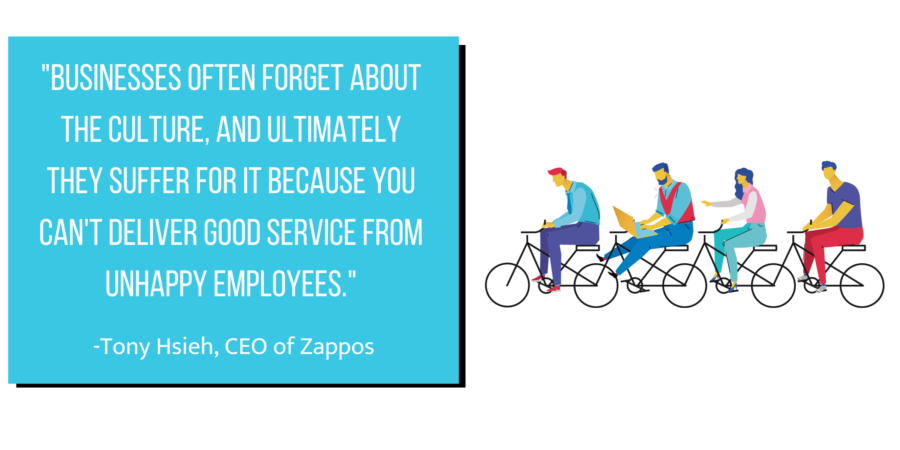
Your enterprise is your employees. Your company’s failure or success will hinge as much on your team’s performance as the viability of your business plan or the demand for your product. Great employees who work well individually and as a group will deliver superior results, bring more innovative ideas to the table, and inspire the same enthusiasm and loyalty in your customers. But you can expect employees who are poorly matched with their jobs to lackluster results, leaving you to deal with performance issues or the prospect of a costly re-hiring process. Tony Hsieh, the CEO of Zappos, estimates that the cost of bad hires for his company was “well over $100 million.” .
It’s no wonder that for Mr. Hsieh and other CEOs, hiring people is a major concern. In fact, the 2019 Conference Board Annual Survey found that hiring people who perform well, and keeping them, was the number one priority of CEOs. At small businesses and startups, where staff and budgets must be lean to compete, the impact of a single bad hire can be disastrous.
When they need to fill an opening, most companies build an employee recruitment team, getting collaborative input from the supervisor for the open role, the CEO, a human resource manager, and the head of the department with the opening (who serves as the designated “hiring manager”). Many companies also work with recruiters, who search out qualified job seekers and headhunt among other companies. If you’ll be serving on an employee recruitment team, you may be wondering if you have the ability to hire the best person for the job.
Fortunately, there’s a science, and an art, to hiring people, and it can be learned.. Getting the right training for this task is crucial. And even if you’ve been trained in best practices for hiring people, you may need a refresher course, since the standards in hiring and recruiting have been changing dramatically in recent years. Whether you want to read some quick, free tutorials or invest in a degree in human resource management, there’s a way for you to improve the way you hire people. And hiring right is a surefire way to improve your company’s bottom line.
Learning to Hire People through Self-Teaching
Many, many people in charge of small businesses and startups make one of two fatal mistakes when hiring people: they go with their gut, or they rigidly apply basic and outdated hiring rules. While business instincts have an important place in decision-making, the practice of hiring people simply can’t be left to intuition. Business owners routinely overestimate the accuracy of their “read” on potential hires, especially given that strong candidates sometimes interview relatively poorly, and underperformers may look great on paper. Falling back on old rules for posting jobs and screening candidates is also a recipe for a less-than-stellar outcome. You’ll need a handle on the basics as well as a sense of how to reach and evaluate today’s job seekers (and potential hires not actively job seeking!). The fastest and cheapest way to get oriented to best practices for hiring people today is to simply familiarize yourself with some tutorials and guides.
Seasoned hiring managers and recruiters have written a number of books on how to hire people. Many of these may even be available as audiobooks, or may e availed through your local library. A few of the more popular books on how to hire people include:
- Knock ’em Dead Hiring the Best, by Martin Yate
- Hire with Your Head, by Lou Adler
- 99 Great Interview Questions, by Paul Falcone
- Who: The A Method for Hiring, by Geoff Smart
There’s also no shortage of guides and tutorials online that teach how to hire people. Most are free, some are modestly priced. Some of the most popular free online guides to hiring people include:
- Indeed’s Guide to How to Hire
- Recruiting Toolbox – Recruiter & Hiring Manager Training
- Monster – Online Recruitment Training
- The “Just Write” YouTube Channel
- Hiring Employees Training suite on Lynda
As you can imagine, self-instruction is only a good fit if you’re a self-starter with high motivation and good time management. When teaching yourself to hire people easy to start off strong and lose your momentum in the absence of outside structure. For those who need more external accountability and more immersive instruction, MOOCs may be a better low-cost way to learn to hire people.
Self-learning Pros:
- easy to choose focus area
- usually free
- start and stop any time
Self-learning Cons:
- no external accountability
- no discussions or feedback
- no interpersonal practice
Learning to Hire People through MOOCS
In the world of higher ed, MOOCs have been a game-changer. If you aren’t familiar with the term, MOOC is an acronym for “massive online open enrollment course.” MOOCs are open to anyone, no application or prerequisites required. They are offered entirely online, and enroll very high numbers of students in each class. While a traditional college classroom usually doesn’t exceed 60 students in even the largest class, MOOCs may have 60,000 students enrolled in a single class! Keeping enrollment numbers high and saving classroom space allows schools to offer classes with prestigious and expert teachers at a very low cost. In fact, many MOOCs are entirely free..
A few excellent MOOCs that teach hiring people and recruitment include:
- Coursera
- Recruiter Training on Udemy
- Inclusive Talent Acquisition on edX
Learning through a MOOC is, by definition, a one-way street. You won’t be having discussions with your professor, presenting to the class, or getting personal feedback in a class of 60,000! Instead, you’ll be studying class materials, listening to expert lectures, and following along with real-world case studies. And some MOOCS do build in opportunities for work in peer-to-peer groups as well. Compared to learning from a book or tutorial, learning from a professor in a MOOC can be a much more immersive experience. And having a syllabus with lessons and assignments can provide the structure that most of us need to learn best. But students who want to really refine their techniques for recruiting, interviewing, and other interpersonal hiring skills may want to consider a traditional class, where they can also learn through lots of personal interaction.
Learning to Write through Classes
Without a doubt, classes offer students the most interactive learning experience. In a class, you’ll learn from your instructor, your classmates, course materials, and group and individual assignments. Discussions, feedback, and questioning will help you understand the material in-depth and allow you to apply your critical thinking.
When it comes to classes on how to hire people, you have several options. Most colleges and universities offer courses in hiring, and business schools offer classes in specific topics related to hiring people, such as recruitment and on-boarding.
A large proportion of the people studying business, including HR and hiring, are working professionals taking classes part-time. That means it’s usually easy to find business classes offered on evenings and weekends, as well as online. Online classes usually combine on-demand content (like video lectures) with video conference or chat sessions to promote peer-to-peer learning and interaction with the course instructor. These face-to-face interactions can be especially important for the proactive of hiring people, which depends largely on interpersonal skills like successful interviewing.
Some course titles you may see offered that apply to hiring people include:
- Effective Hiring and Interviewing
- Human Capital and Workforce Capability Development
- Human Resource Metrics and Talent Analytics
- Workforce Diversity and Inclusion
- Ethical and Legal Issues in Hiring
This method of learning to hire people is a great approach if you thrive on collaboration, personal attention, external motivation, and structure. You can expect your course instructor to be your coach as well as your teacher, giving you personal feedback to develop your skills. But you’ll need to be prepared to compensate your instructor for this level of hands-on service and professional expertise. Classes usually cost several hundred dollars per credit, and you’ll likely pay additional costs, such as an enrollment fee. You will also need to go through an application process to enroll in most hiring classes.
Hiring Class Pros:
- feedback provided
- higher structure
- personal attention
Hiring Class Cons:
- high cost
- time consuming
Learning to Hire People through Degree Programs
If you’ve been asked to step in and handle hiring as part of an employee recruitment team, you’ll want to learn the fundamental skills needed to hire people through books, tutorials, MOOCs, or classes. But if you have found that you love the challenge of discovering people and bringing them into your company’s fold, you may want to make a career out of hiring and retaining talent. For that, you’ll need a business degree.
If you want to be in charge of hiring people, you should pursue a career in human resources management or recruiting. Both HR managers and recruiters generally start with a business degree. Some people earn a bachelor’s degree in business, others get a bachelor’s degree in a relevant field such as communications or psychology. Those already in the business field who want to boost their careers should consider an MBA (master’s of business administration) with a concentration of human resource management. If you’ve worked in human resources or a related field of business for several years, and have decided that you’d like to focus exclusively on hiring people, you can pursue work at a recruiting firm.
A degree in human resource management demonstrates to employers your expertise in all aspects of hiring, developing, and retaining talent. It also shows your quality of work and professional commitment. A degree program, like a class, is a structured way to learn. The curriculum has been designed from start to finish to prepare you to hire, retain, and develop personnel; you’ll start off with the fundamentals of business, and finish with advanced and classes related to the specific skills like on-boarding and internet recruiting.
A degree is more than a collection of classes. When you’re enrolled as a student in a degree program, you’ll be able to join academic groups, participate in research, collaborate with partner businesses, and perform internships. You’ll also have access to resources like an academic advisor, career counselor, and alumni network.
There’s no denying, however, that degree programs are costly, both in terms of time and money. Some institutions, such as state schools, tend to be more affordable than others. And some programs are offered in an accelerated format, so you can finish your degree faster. But even so, earning a business degree is a serious investment, requiring years of work and thousands of dollars.
INSERT SMALL GRAPHIC ICONS: thumbs up for pros, thumbs down for cons
HR Degree Pros:
- structured curriculum
- student, professor and alumni network
- broad career options for business degrees
HR Degree Cons:
- not necessary to serve on hiring team
- highest cost
- 4+ years to complete
Learning Options
Which way of learning to hire people makes the most sense for you? Your learning style, goals, and resources will determine how you choose to study this topic.. If you’re a self-disciplined and motivated pupil, you can pick up the basics from an online tutorial, a guide, or a book on how to hire people. If you want more engaging and directed learning, a MOOC or a traditional class may be the right choice for you. A business degree, specifically a degree in Human Resource Management, is the way to go if you envision a future in recruiting and hiring, along with talent retention and development.

